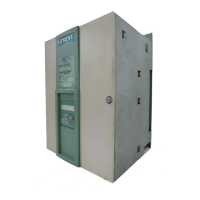05.05 Function descriptions
SIEMENS AG 6RX1700-0AD76 9-35
SIMOREG DC Master Operating Instructions
9.15.2 Configuring for dynamic overload capability
Section 9.15.3 provides the following information for each converter model:
− Maximum overload period
t
an
for starting with cold power section and specified constant overload
with an overload factor of X (i.e. loading with X times the converter rated DC current * P077) (see
small table at top right)
− Maximum current interval
t
ab
(maximum cooling time) until the power section reaches the "cold"
state (see below small table at top right)
− Limit characteristics fields for calculating overload capability
in thermally settled, intermittent
overload operation (periodic load cycles).
(In tabulated form: Top left
As curve with logarithmic y axis: Curve at bottom left
As curve with linear y axis: Curve at bottom right)
Important
:
The power section is in the "cold" state when the calculated thyristor temperature corresponds to less
than 5 % of its maximum permissible value. This state can be scanned via a binary selectable output.
Note:
If load cycles are started with a cold power section at least slightly within the specified load cycle
limits, then the thermally settled state can be reached without tripping the I
2
t monitor.
If the I
2
t monitoring function is parameterized for a shutdown response (P075 = 2), the converter
should not be allowed to operate too close to the limit characteristic when periodic load cycles are
configured with a load cycle time of longer or slightly shorter or equal to 300 s.
In all other cases, and especially when parameterizing reduction of the armature current setpoint
(P075 = 1) as the I
2
t monitoring trip response, it is possible to fully utilize the maximum overload
capability defined by the limit characteristic.
Structure of limit characteristics fields for intermittent overload duty:
Each characteristics field refers to a load cycle of intermittent overload operation with a total period
of
300 s.
This type of load cycle consists of two periods,
i.e. the base-load duty period
(armature actual current ≤ P077 * converter rated DC current)
and the overload period
(actual armature current ≥ P077 * converter rated DC current).
Each limit characteristic displays the maximum permissible overload period Tp
over
the maximum base-load current Ig for a specific overload factor X for each converter model.
For the remainder
of the load cycle, the current may not exceed the base-load current as defined by
the overload factor.
If no limit characteristic is specified for a particular overload factor, then the characteristic for the next-
higher overload factor must be applied.
The limit characteristics fields apply to a load cycle time of 300s.
For load cycle times of < 300s, the overload period must be reduced proportionally (load cycle/300s).
For load cycle times of > 300s, the overload period is the same as that for a cycle time of 300s, but the
base-load period is correspondingly longer.
The limit characteristics fields apply for a setting of P077 = 1.00. If P077 is set to ≤ 1.00, i.e. in the
case of thermal derating, the currents which actually flow must be weighted with a factor of 1/P077:
Overload factor X for characteristic =
Actual overload current
P converter rated DC current077*
Actual maximum base-load current = P077 * max. base-load current acc. to character-
istic in % of converter rated DC current

